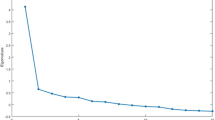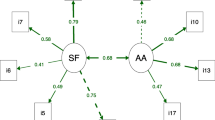Abstract
Objective
To evaluate the measurement properties of the Brazilian version of the Copenhagen Neck Functional Disability Scale (CNFDS) in patients with chronic neck pain.
Methods
One hundred and five patients were included in the study. The structural validity of the CNFDS was assessed by exploratory and confirmatory factor analysis with the following fit indices: chi-square divided by degrees of freedom (chi-square/df), root mean square error of approximation (RMSEA), comparative fit index (CFI), and Tucker-Lewis index (TLI). To test the construct validity, the CNFDS score was correlated with the Numerical Pain Rating Scale, the Tampa Scale of Kinesiophobia, the Pain-Related Catastrophizing Thoughts Scale, and Neck Disability Index (NDI). A subsample of 43 patients filled the CNFDS at two different times, and test–retest reliability was measured using the intraclass correlation coefficient (ICC), standard error of measurement (SEM), and minimum detectable change (MDC). The internal consistency of the CNFDS was analyzed by Cronbach's alpha.
Results
CNFDS presented a unidimensional structure, with goodness of fit indices: chi-square/df = 1.37, CFI = 0.94, TLI = 0.93, RMSEA = 0.059. The CNFDS showed satisfactory results of reliability (ICC = 0.93) and internal consistency (Cronbach's alpha = 0.84). The SEM was 1.72 and the MDC was 4.76. The CNFDS showed a high correlation with the NDI (rho = 0.718) and a low correlation with the other instruments. There were no floor and ceiling effects.
Conclusion
The Brazilian version of the CNFDS with a one-dimensional structure and 15 items has adequate measurement properties.


Similar content being viewed by others
Availability of data and material
None.
References
Childs JD, Cleland JA, Elliott JM et al (2008) Neck pain: Clinical practice guidelines linked to the international classification of functioning, disability, and health from the orthopaedic section of the american physical therapy association. J Orthop Sports Phys Ther 38:A1–A34. https://doi.org/10.2519/jospt.2008.0303
Terwee CB, Prinsen CAC, Chiarotto A et al (2018) COSMIN methodology for evaluating the content validity of patient-reported outcome measures: a Delphi study. Qual Life Res 27:1159–1170. https://doi.org/10.1007/s11136-018-1829-0
Cook C, Richardson JK, Braga L, et al (2006) Cross-cultural adaptation and validation of the Brazilian Portuguese version of the Neck Disability Index and Neck Pain and Disability Scale. Spine (Phila Pa 1976) 31:1621–1627. Doi: https://doi.org/10.1097/01.brs.0000221989.53069.16
Kamonseki DH, Cedin L, Tavares-Preto J et al (2017) Translation and validation of neck bournemouth questionnaire to Brazilian portuguese. Rev Bras Reumatol 57:141–148. https://doi.org/10.1016/j.rbre.2016.11.006
Ferreira MC, Björklund M, Dach F, Chaves TC (2017) Cross-cultural adaptation of the profile fitness mapping neck questionnaire to brazilian portuguese: internal consistency, reliability, and construct and structural validity. J Manipulative Physiol Ther 40:176–186. https://doi.org/10.1016/j.jmpt.2017.01.004
Badaró FAR, Araújo RC, Behlau M (2014) The Copenhagen neck functional disability scale—CNFDS: translation and cultural adaptation to Brazilian Portuguese. J Hum Growth Dev 24:304–312. https://doi.org/10.7322/jhdg.88965
Jordan A, Manniche C, Mosdal C, Hindsberger C (1998) The Copenhagen neck functional disability scale: A study of reliability and validity. J Manipulative Physiol Ther 21:520–527.
Angilecchia D, Mezzetti M, Chiarotto A et al (2018) Development, validity and reliability of the Italian version of the Copenhagen neck functional disability scale. BMC Musculoskelet Disord 19:1–9. https://doi.org/10.1186/s12891-018-2332-z
Elbeltagy AM, El Sayed WH, Allah SSR (2018) Validity and reliability of the Arabic version of the Copenhagen Neck Functional Disability Scale in neck pain patients. Asian Spine J 12:817–822. Doi: https://doi.org/10.31616/ASJ.2018.12.5.817
Ghasemi F, Kordi Yoosefinejad A, Pirouzi S, Ghaem H (2019) Evaluating the cross-cultural adaptation, reliability, and validity of the Persian versions of the copenhagen neck function disability scale and neck bournemouth questionnaire. Spine (Phila Pa 1976) 44:E126–E132. Doi: https://doi.org/10.1097/BRS.0000000000002781
Yapali G, Günel MK, Karahan S (2012) The cross-cultural adaptation, reliability, and validity of the copenhagen neck functional disability scale in patients with chronic neck pain: Turkish version study. Spine (Phila Pa 1976) 37:678–682. Doi: https://doi.org/10.1097/BRS.0b013e31824b549c
Forestier R, Françon A, Saint AF, Bertolino C (2007) French version of the Copenhagen neck functional disability scale. Jt Bone Spine 74:155–159. https://doi.org/10.1016/j.jbspin.2006.03.002
Misterska E, Jankowski R, Glowacki M (2011) Cross-cultural adaptation of the Neck Disability Index and Copenhagen Neck Functional Disability Scale for patients with neck pain due to degenerative and discopathic disorders. Psychometric properties of the Polish versions. BMC Musculoskelet Disord 12:1–8. https://doi.org/10.1186/1471-2474-12-84
Mokkink LB, Prinsen CA, de Patrick DLJALMBHC, VCB, (2019) COSMIN study design checklist for patient-reported outcome measurement instruments. Amsterdam University Medical Centers, Amsterdam
Prinsen CAC, Mokkink LB, Bouter LM et al (2018) COSMIN guideline for systematic reviews of patient-reported outcome measures. Qual Life Res 27:1147–1157. https://doi.org/10.1007/s11136-018-1798-3
Dibai-Filho AV, De Oliveira AK, Girasol CE et al (2017) Additional effect of static ultrasound and diadynamic currents on myofascial trigger points in a manual therapy program for patients with chronic neck pain: a randomized clinical trial. Am J Phys Med Rehabil 96:243–252. https://doi.org/10.1097/PHM.0000000000000595
Ferreira-Valente MA, Pais-Ribeiro JL, Jensen MP (2011) Validity of four pain intensity rating scales. Pain 152:2399–2404. https://doi.org/10.1016/j.pain.2011.07.005
Siqueira FB, Salmela LFT, de Magalhães L, C, (2007) Análise das propriedades psicométricas da versão brasileira da escala tampa de cinesiofobia. Acta ortop bras 15:19–24
Junior JS, Nicholas MK, Pereira IA et al (2008) Validation of the Pain-Related Catastrophizing Thoughts Scale. Bangladesh J Med Sci 34:1–17
Lorenzo-Seva U, Ferrando PJ (2019) Robust Promin: A method for diagonally weighted factor rotation. Lib Rev Peru Psicol 25:99–106. Doi: https://doi.org/10.24265/liberabit.2019.v25n1.08
Tabachnick BG, Fidell LS (2007) Using Multivariate Statistics, 4th edn. Boston: Allyn and Bacon, MA; 2001. Allyn and Bacon, Boston
Pontes-Silva A, Avila MA, Fidelis-de-Paula-Gomes CA, Dibai-Filho AV (2021) The short-form neck disability index has adequate measurement properties in chronic neck pain patients. Eur Spine J. https://doi.org/10.1007/s00586-021-07019-4
Fleiss JL (1986) The design and analysis of clinical experiments. Wiley, New York
Pickering PM, Osmotherly PG, Attia JR, McElduff P (2011) An examination of outcome measures for pain and dysfunction in the cervical spine: A factor analysis. Spine (Phila Pa 1976) 36:581–588. Doi: https://doi.org/10.1097/BRS.0b013e3181d762da
Hayton JC, Allen DG, Scarpello V (2004) Factor retention decisions in exploratory factor analysis: a tutorial on parallel analysis. Organ Res Methods 7:191–205. https://doi.org/10.1177/1094428104263675
Marx RG, Menezes A, Horovitz L et al (2003) A comparison of two time intervals for test-retest reliability of health status instruments. J Clin Epidemiol 56:730–735. https://doi.org/10.1016/S0895-4356(03)00084-2
Funding
This work was partially supported by Coordenação de Aperfeiçoamento de Pessoal de Nível Superior (CAPES), finance code 001. The funders had no role in study design, data collection and analysis, decision to publish, or preparation of the manuscript.
Author information
Authors and Affiliations
Contributions
Data collect: FSB; Data analysis: FSB and AVDB; Design: all authors; Manuscript writing: all authors; Final approval of manuscript: all authors.
Corresponding author
Ethics declarations
Conflicts of interest
The authors report no conflicts of interest.
Ethics approval
All procedures performed in studies involving human participants were in accordance with the ethical standards of the institutional and/or national research committee and with the 1964 Helsinki declaration and its later amendments or comparable ethical standards.
Consent to participate
Informed consent was obtained from all individual participants included in the study.
Consent for publication
The consent for publication was obtained from all individual participants included in the study.
Additional information
Publisher's Note
Springer Nature remains neutral with regard to jurisdictional claims in published maps and institutional affiliations.
Supplementary Information
Below is the link to the electronic supplementary material.
Rights and permissions
About this article
Cite this article
Barreto, F.S., Pontes-Silva, A., Oliveira, F.L.B. et al. Measurement properties of the Brazilian version of the Copenhagen Neck Functional Disability Scale in patients with chronic neck pain. Eur Spine J 31, 346–352 (2022). https://doi.org/10.1007/s00586-021-07070-1
Received:
Revised:
Accepted:
Published:
Issue Date:
DOI: https://doi.org/10.1007/s00586-021-07070-1




